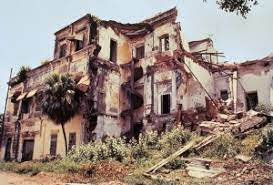 |
| House of Wellesley, Ft St. George, Chennai. thehindu.com |
Above image: Wellesley House in ruins, photo taken in 2016. This is the remaining portion of Wellesley House on Charles street, Ft. St. George. Chennai. Reason for this kind of collapse: When the building had been lying in a state of disrepair and structurally weak no responsible government agency came forward to save this structure and the adjacent Chaplain house despite protests from heritage lovers and frequent media reports. Several years ago recovery of this building was possible. But total apathy on the government side pushed this heritage to this present state of almost total decay. ..............
 |
| Wellesley House, Chennai, total wreck madrasmusings.com |
Above image: Appeared in Madras Musing's article in April 2016. Like many other old structures soon it will disappear, never to be returned. When the building collapsed several years ago and had remained uncared for since then, it was more of a symptom of its death knell............
Chennai has lost many outstanding colonial structures in the past several decades and the heritage enthusiasts are quite dismayed over their loss. They are now keeping their figures crossed over the fate of Gokhale Hall, Victoria Town hall, the Bharat insurance building and many others. They may decay and fall on their own in a few years from now or likely they may be saved. The same story goes on in cities like Kolkata and Delhi. Coming back to Chennai quite disgusting is the slow death of Wellesley House in the fort area. The Lost Post was already played for this early colonial structure.
 |
| Gov. Gen. of India Richard Wellesley.commons.wikimedia.org |
Above image: Portrait: Wellesley in officer's uniform with star and sash of the Order of St Patrick. Portrait by Robert Home, famous oil portrait painter. This work was done in India in 1791. Richard Colley Wellesley, 1st Marquess Wellesley of Norragh, (20 June 1760 – 26 September 1842; got the Irish peerage in 1799) was an Anglo-Irish politician (Tory), colonial administrator and elder brother of Arthur Wellesley whose successful raid against won the final Angelo-Mysore war. against Tipu Sultan. During his tenure as the Gov. of Madras Presidency he stayed in the Wellesley House in the fort. He ran the administration well, choosing his brothers Arthur and Henry as his PAs. He was the founder of Ft. William College in Calcutta ( July 10, 1800; Kolkata) to train British in some aspects of administration plus learning of Indian language like Urdu, Sanskrit. Persian, Bengali, etc. He promoted Indian languages to run the administration. After his death in 1842, he was buried in Eton College Chapel, at his old school, London........................................
 |
| Damaged Wellesley House, Ft. St. George, Chennai. rip101.com |
Wellesley House, Chennai named after Richard Wellesley, Governor-General of British India (1798 - 1805) is on the quiet Church/Charles Street at Fort St. George just before the San. Thome Gate. Sheer negligence on the part of the official is writ in that place where a large number of historical buildings have disappeared over a period of time What was once a nice building has become a dilapidated site with broken walls, etc . Most of the site is further damaged by the growth of a big banyan tree whose roots seem to support the remaining structure. Structural damages were severe on account of climatic vagaries and root -wedging promoted by the growth of plants, particularly the big banyan tree. Remained uncared for a long time, way back on 18 November 1980 a large part of the house caved in creating a huge mound of fragmented materials. That decades back no attempt was made to remove the banyan tree that had grown on the huge walls is a sad story. The remaining structures in the adjacent areas in the fort still stand neglected. This' ll give some idea about the way our government officials cared about the historical places, buildings, etc., decades ago..
This once a bungalow with large rooms, windows, a wide stairway is in total ruins. Built in 1796 as per the faded plaque embedded on the damaged wall, the house was used by Wellesley brothers - Arthur and Richard.
In the final Angelo-Mysore war (in 1798-1799) 1799 at Srirangapatna (now in Mandya District, Karnataka) against Tipu Sultan of Mysore who terrorized the English company, one of the three English armies involved was commanded by Colonel Arthur Wellesley, the future 1st Duke of Wellington). It is said Richard came to Madras en route to Mysore and stayed in the house. In February 1799, both Wellesleys marched to Mysore. On 4 March Tipu was shot and killed by the troop led by Arthur. After the war Richard returned to Calcutta. An interesting fact is at that point of time of waging the war against Tipu, the government treasury was low on money, a glaring deficit worried the right-mined officials. But the British army was keen to get Tipu out of the way so that they could annex Mysore.
http://www.madrasmusings.com/vol-25-no-24/know-your-fort-better-16/
https://en.wikipedia.org/wiki/Richard_Wellesley,_1st_Marquess_Wellesley









